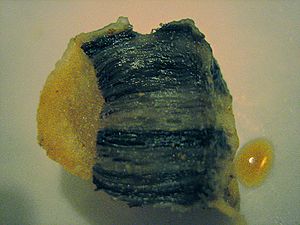Blubber facts for kids
Blubber is a thick layer of fat found under the skin of many sea animals. These include whales, seals, penguins, and manatees. It helps them survive in cold water and stores energy.
Contents
What is Blubber?
Blubber is a special kind of fat tissue. It covers almost the entire body of these animals, except for their fins or flippers. It is strongly connected to their muscles and bones.
For some sea mammals, blubber can make up to half of their body weight! Its thickness can vary a lot. For example, in dolphins and smaller whales, it might be about 2 inches (5 cm) thick. But in huge whales like the right whale or bowhead whale, it can be more than 12 inches (30 cm) thick.
However, a thicker blubber layer doesn't always mean better heat retention. What really matters is how much water and fat are in the blubber. More fat helps keep heat in, while more water makes it harder to stay warm.
How Blubber Helps Animals
Blubber is very important for animals that live in water. Here's how it helps:
Energy Storage
Blubber is the main way these animals store fat. This is especially useful for species that travel long distances to feed or have babies. During these journeys, they use the stored fat for energy.
Staying Warm
Blubber acts like a warm blanket, keeping the animals warm in cold ocean water. It's full of tiny blood vessels. When an animal dives into cold water, these blood vessels can get smaller. This reduces blood flow to the blubber, making it even better at keeping heat inside the body.
Blubber is better than fur for animals that dive deep. Fur keeps animals warm by trapping air. But when an animal dives deep, the water pressure squeezes the air out of the fur. Blubber, however, does not get squeezed by pressure. This means it keeps working as an insulator even when an animal is deep underwater. Some whales can live comfortably in water as cold as 40°F (4°C) thanks to their blubber!
Floating and Moving
Blubber also helps these animals float easily in the water. This is called buoyancy. It can save energy when they swim. Blubber also helps make their bodies smooth and streamlined, which helps them move through the water more easily.
Scientists have studied the blubber of bottlenose dolphins. They found that its thickness and fat content change depending on the dolphin's age and if it's pregnant. Blubber from healthy adult dolphins keeps heat in better than blubber from very thin dolphins. Pregnant females and young dolphins also have blubber that is very good at keeping them warm.
Blubber and Humans

Traditional Uses
For people like the Inuit in the Arctic, blubber (called Uqhuq or uqsuq) has been a very important part of their traditional diet. It provides a lot of energy and is readily available in their environment.
In the past, whaling was done mainly to get blubber. Whalers would melt the blubber in large pots called try pots to make whale oil. This oil was used to make soap, leather, and cosmetics. It was also used as wax for candles and as fuel for oil lamps. A single blue whale could provide up to 50 tons of blubber!
Health Benefits
Blubber from whales and seals contains healthy omega-3 fatty acids and vitamin D. Vitamin D is very important for strong bones. Without it, people can get a disease called rickets. The fats in blubber also provide the high amount of calories needed by people living in the cold Arctic, where other foods like carbohydrates are scarce.
Pollution Concerns
Today, blubber can contain harmful man-made chemicals like polychlorinated biphenyls (PCBs). These chemicals can damage the nervous, immune, and reproductive systems. Scientists believe that animals higher up in the food chain, like toothed whales, eat a lot of smaller animals that have already absorbed these pollutants. This means the toxins build up in their bodies. Even large baleen whales, which eat huge amounts of tiny organisms, can have these chemicals stored in their blubber. Seals in the Canadian Arctic also have high levels of mercury in their blubber.
See also
 In Spanish: Grasa de ballena para niños
In Spanish: Grasa de ballena para niños
- Globster
- Greenlandic cuisine
- Muktuk (a traditional Inuit food made from whale blubber and skin)
- Whale meat


